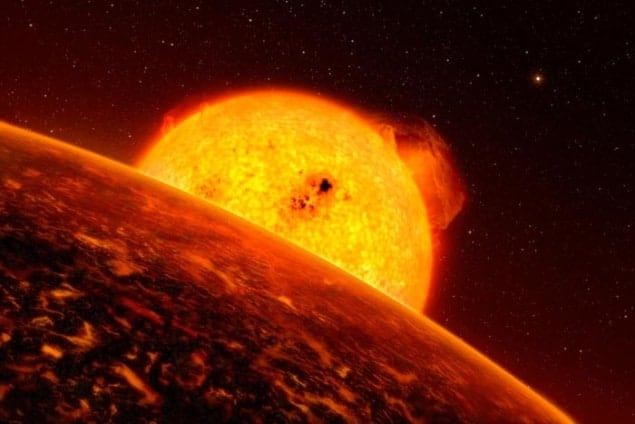
Astronomers have obtained the best evidence yet that a planet orbiting a star 400 light years away from Earth is a solid, rocky world just like our own.
The extrasolar planet (or exoplanet), known as CoRoT-7b, was discovered earlier this year by the French CoRoT space telescope, which established that the body has a radius less than twice that of Earth and orbits extremely close to its parent star. Temperatures on the planet are expected to be as high as 2000 °C, which led astronomers to assume that it was comprised of molten and solid rock, rather than frozen gases, because the latter would boil away under such conditions.
Density a mystery
This assumption could not, however, be confirmed because CoRoT measures the shadow cast by the exoplanet as it crosses between Earth and its star, giving the radius of the exoplanet, but not its mass and density.
Now, though, an international team of astronomers led by Didier Queloz of Switzerland’s Geneva Observatory has used the HARPS spectrograph at La Silla Observatory in Chile to measure the mass of CoRoT-7b. HARPS makes very accurate measurements of the velocity of the planet’s parent star, which allows astronomers to observe the “wobble” induced on the star by the orbiting planet.
By observing this wobble for a total of 70 hours over several months, the team concluded that CoRoT-7b has a mass about five times that of Earth. The density is therefore about the same as Earth, suggesting that the exoplanet has a similar rocky composition.
All in a wobble
However, some other astronomers are not as certain. Suzanne Aigrain at the University of Exeter in the UK told physicsworld.com that the parent star is particularly active (covered in spots), which results in apparent changes to its velocity that are greater than those induced by CoRoT-7b. These variations had to be removed from the HARPS data, leading to uncertainties in the mass of CoRoT-7b that may “have been seriously underestimated”.
However, Aigrain, who was involved in the discovery of CoRoT-7b, says that some degree of controversy is unavoidable when researchers are trying to push back the limits of what can be done with state-of-the-art instruments. “Now it is very important that the entire community works towards the consolidation of this result by re-analysing the data with a variety of techniques and by continuing to gather data on this very interesting object,” she says.
Although the exoplanet may bear some resemblance to Earth, Queloz does not expect it to harbour life, comparing the exoplanet to Dante’s Inferno, with the probable temperature plummeting from above 2000 °C during the day to –200 °C at night. “Theoretical models suggest that the planet may have lava or boiling oceans on its surface,” he says. “With such extreme conditions this planet is definitively not a place for life to develop.”
The research will be published next month in Astronomy and Astrophysics.



